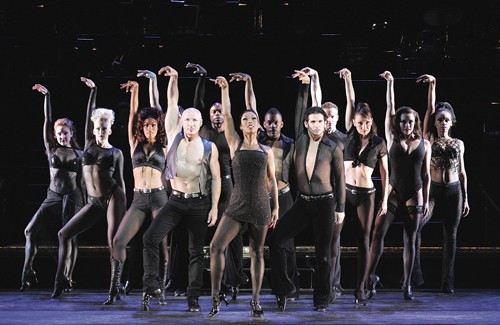Greed, treachery, adultery and murder. All appeared on the Tucson Community Center stage last night for the opening of “”Chicago the Musical.””
“”Chicago”” presents the story of Roxie Hart, the wife of an auto mechanic and played by Bonnie Langford, who fools around with the furniture seller Fred Casely (Brent Heuser), and murders him when he tries to leave the relationship. Roxie then enters “”murderess row,”” where the prisoners are known for killing their husbands and lovers. There she meets Velma Kelly (Terra C. MacLeod) who then introduces Roxie to the smarmy lawyer Billy Flynn (John O’Hurley). He plans to spin Roxie’s upcoming trial in her favor, but Roxie has other ideas in mind.
The musical opened with MacLeod performing the number “”All That Jazz,”” one of the show’s most memorable songs. Kelly was joined by other scantily clad vaudeville dancers moving in a way that would make Fosse proud.
Some of the numbers were extremely entertaining. “”Cell Block Tango”” had the audience roaring with laughter as each woman on murderess row kept adding their comical, sexually suggestive tweaks to their monologues, from squeaky voices to hip thrusts to high kicks. MacLeod brought a lot of energy to “”I Can’t Do It Alone”” with her authentic, sassy vaudevillian dancing.
O’Hurley’s Flynn was as snarky as ever. His windpipes were polished and impressive. The sound that came out of O’Hurley was very unexpected because he conveyed a sense of experience with his controlled vocals. He greatly embodied Flynn.
Matron “”Mama”” Morton, played by Carol Woods, had a stage presence that was bigger than life. Her chops would make anyone jealous. In the song “”Class,”” Woods and MacLeod kept the audience laughing with their tidbits of profanity.
Amos Hart, played by Tom Riis Farrell, thick with Canadian accent, elicited more sympathy than his movie counterpart. He won over the audience’s “”Harts”” with his lonely act and jazz-handed “”Mister Cellophane.””
Unfortunately, the cast was not helped with the staging, which was bland and monochromatic. There were few props and no set changes. Lighting was used to dramatize the actors, and the stage occasionally adding fuchsia and red into the dark theatre. With only lighting and a few props, it was difficult to keep track of the scene changes.
The show moved extremely fast and the minimal set changes led to some confusion. It was hard to tell when the scenes changed or where certain acts took place. When Roxie shoots Fred, it appeared to happen in the nightclub during “”All that Jazz,”” when in reality it happened at Hart’s place.
There were also no costume changes. All the chorus members who played characters from reporters to judges, stayed in their mesh tops and fishnets. It was difficult to take them seriously.
When an actor was killed from the 18-member cast, she would reappear onstage minutes later. The overlap became distracting.
Overall the dancing was quite impressive, from the man-splits to the renditions of the Charleston. Confetti and disco balls also helped top off the “”razzle-dazzle”” show. Although the dancing was impressive throughout the show, it got a little sloppy toward the end. When Kelly and Hart performed “”Hot Honey Rag,”” the two seemed a little off synch.
The orchestra stuck out like a sore thumb since it was placed dead center in the only “”set”” of the show. Occasionally the actors would interact with the musicians and conductor incorporating them into the scene.
The show was entertaining, but it wasn’t entirely convincing. The all-star cast made it worthwhile, yet without the support of the sets and costumes, the show fell a little flat.
In the words of Billy Flynn, “”That’s Chicago.””









